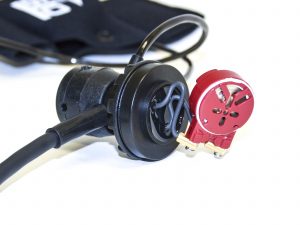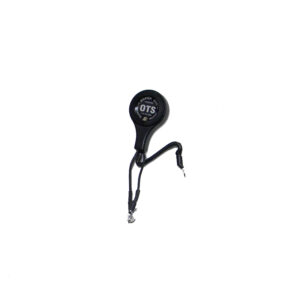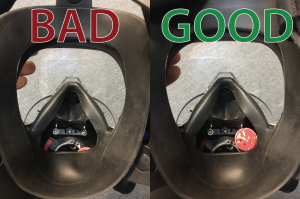Wireless Communications Tips and Tricks
Wireless diver communications can be a very effective tool in any diving related activity. However, taking advantage of this technology does take a bit of learning. It’s not a simple matter of donning the gear and just pushing the button. There are many factors that can affect the transmission or reception of your communications and just about every environment is different. Proper fitting of the Full Face Mask, correct use of the equipment as well as a good understanding of how communications work and conditions that interfere with the signal will go a long way in ensuring the best performance possible.
Types of Wireless Underwater Communications
OTS offers two types of diver worn wireless communications systems, the Buddy Phone and belt/equipment mounted devices. The Buddy Phone is mask mounted and the SSB/MAGNACOMs are belt/equipment mounted. Adding surface communications to these and will allow the “communications triangle”; diver to diver, diver to surface and surface to diver.
The Buddy Phone is an all-inclusive unit that mounts to the head harness strap of a diver’s Full Face Mask. This unit has the transducer, electronics, battery, earphone and cable to the microphone/Push To Talk (PTT) assembly in one compact package. The Push To Talk buttons are mounted to the masks and due to the differences in mounting methods between Full Face Masks, OTS offers various Buddy Phone models. To see a list of Buddy Phones offered, please visit our Buddy Phone page. Buddy Phones are relatively low power (.5 watts) and are designed for what the name applies, talking to your dive buddy. The latest models of Buddy Phones come with two channels that can be changed by manipulation of the PPT button. To see how to operate the Buddy Phone, please watch our instructional video.
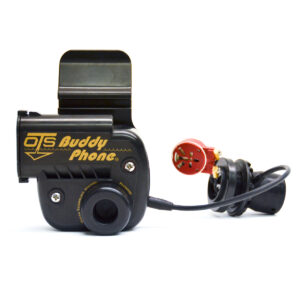
Buddy Phone
The SSB units and MAGNACOM family of diver units are higher powered and designed to be mounted on the diver’s equipment such as the tank strap or waist strap. The SSB 2001/2010/1001B diver units are most commonly used in sport, commercial, public safety and military diving applications. Transmission ranges of the SSB units can extend from 1000 to more than 1500 meters under good conditions (explained later). The MAGNACOM diver communications units are very high power units primarily designed for military applications or wherever long-range communications are required. Transmission ranges of the MAGNACOM communications systems can reach from 3000 to 5000 meter and beyond depending on conditions. All of OTS’ higher powered diver units are used with ear/microphone assemblies that are specific to the Full Face Mask being used. These ear/mic assemblies have a pair of earphones mounted inside neoprene pouches attached to the head harness, a microphone mounted on a PPT button with a cable and a wet pluggable Hi-Use Connector that marries to the diver unit.
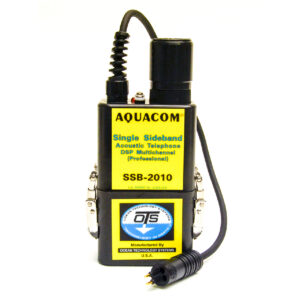
SSB2010
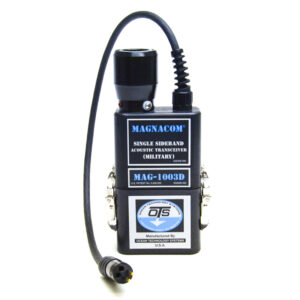
MAG-1003D
Each of the categories of diver units has corresponding surface stations that match in power output and frequencies to the diver units. The SP-100-D2 for the Buddy Phones, STX-101/M AQUACOM for the SSB diver units and the MAG-1001S for the MAGNACOM diver units. The SSB diver units can also be converted to portable surface stations with a headset/transducer cable kit (CDK-6). Almost all of the OTS wireless communications are cross compatible (common frequencies) with one another, except for a small number of MAGNACOM units that are for MIL/LE use only.
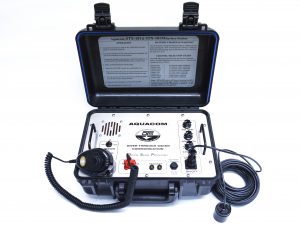
STX-101 Surface Station
Environmental Conditions and Equipment Configuration
Wireless underwater communications use an ultrasonic signal, high frequency sound to transmit. OTS typically uses 25-33 Khz for the majority of units and applications, however lower frequencies such as 8-11 Khz may be used for some high power units. Wireless communications depend on the incompressibility of water to send a signal long distances. With a lower powered device, such as the Buddy Phone that puts out between one quarter to one half of a watt of energy, you can obtain ranges in excess of 400 meters under “good conditions”. Good conditions consist of calm, “quiet” water, relatively shallow with a fairly solid, flat bottom with depths between 8 to 20 meters.
To better understand this, think of the transmission signal as a sound in different environments. A good analogy is that of a large conference hall. In an empty conference hall with a concrete floor that is quiet, without people talking nor equipment running and nothing to obstruct sound, you might be able to hear someone speak in a normal voice from a hundred meters away. Now, imagine the same hall but fill it with people, display booths, carpet the floors and associated noise and you’ll be hard pressed to hear someone speak this same normal voice just five meters away. Water is no different than these two scenarios. Ambient noise, phyiscal obstructions as well as surface and bottom conditions will have a significant effect on the efficiency of wireless communication transmissions.
Thermoclines
Thermoclines will also affect your communications and act as a reflective and refractive barrier. Depending on the oblique angle, it’s possible for as much as 90% of the signal to be reflected off. Also, the signal can be refracted or bent significantly as the remaining signal penetrates the thermal layer. Take this example from Training Director John Hott to better understand how thermoclines can affect communications.
“Once while diving off Catalina Island, I noticed a heavy thermocline around ten meters. My dive buddy turned right when he was supposed to turn left. He argues as to what direction we had planned on turning, but regardless, he ended up about fifty or so meters away. Knowing about how far away he was and where the thermocline was, we set up an impromptu test. With the two of us below the thermal layer our communications were excellent. He stayed below the layer and I adjusted my depth only a meter above the layer, a total of about two meters. His signal was completely gone. There was no echo, no weak signal, there was no signal. I sank down below again and there his signal was as before.”
As stated previously, the more oblique the angle, the more degrading effect. This is the same phenomenon that allows submarines to hide under thermal layers in naval warfare to avoid detection. In the application of communications there are several things you can do to minimize this effect. First, when diving, report to your surface station and other divers that you’ve entered through a thermocline and its depth. Ascend if necessary to make this report. Next, lower the surface transducer into the same thermal layer as the divers if possible. If it is not possible, position the surface station’s transducer as close to overhead of the divers as possible. Decreasing the angle of transmission of the signal will ensure the best performance through the layer.
Objects, Obstructions and Body Shadowing
Objects or obstructions can also interfere with the transmission, which results in shadowing or reflections of the signal. In general, the signal is best transmitted line of sight. An object that does not allow the signal to pass through will stop the signal; for example, this can be reef structure, a ship’s hull or a diver. Body shadowing is one of the most significant obstructions a signal can have. Any airspace on the diver will “shadow” the signal on the side opposite from the transducer. This can be best negated or minimized by placing the diver unit in a position where it will “see” the other transceivers. The Buddy Phone is mounted on the head harness on the side of the diver’s head. If shadowing is a affecting signal transmission, a simple turn of the head will resolve shadowing caused by the airspace in the diver’s head or more so, the divers hood. Drysuits, wetsuits, BCD bladders, cylinders, diver’s lungs or any airspace will effectively kill the signal. Often witnessed, the worst place to put a transceiver is tucked between a BCD against the diver’s body. Typically it is recommended to wear an SSB style unit on the side of my cylinder strap, behind the left shoulder blade. This allows for the best transmission while working on the bottom to communicate with the surface. If shooting video and recording communications from other divers to the camera, then it is recommended to wear the transceiver in the front of the diver to allow for the best line of sight from their respective transceivers. Many equipment configurations and circumstances must be taken into consideration when positioning the transceiver. Implementing these practices will allow you to optimize the placement of your equipment and maximize signal transmission. You may never be able to completely eliminate the shadowing effect however, knowing where your shadow is will allow you to minimize the degrading effects. A slight rotation when communicating could be the subtle difference needed to get the stronger signal required. It is important to remember that for wireless communications to work effectively, one transducer needs to be able to receive the signal from the other and vise-versa.
Reflections
Reflections can cause echoes, but may also work to your advantage. If diving next to a ships hull with a relatively solid bottom below you, the signal heard from the other side may be a direct reflection off the bottom. When diving around sea walls or other flat surfaces, it’s possible to hear a sharp echo of the communications. To test this, try whistling into the keyed mic from the surface station and a release will give you a reflection off of any flat surfaces as well as the the bottom, if it’s far enough away. With little practice, a user may be able to estimate how far a surface is by timing the return signal, acting as rudimentary sonar. The negative effects of reflections (or echoes) are seldom more than a nuisance.
Ambient Noise
Ambient sounds in an area are often as varied as the locations themselves and time of day can affect ambient noise levels. In some locations, shrimp will be louder at different times of the day, which can translate into a “louder” underwater environment which can degrade performance. There many things that can generate noise such as: ships, boats and personal watercraft traffic are common noise generators. First stage regulators as well as first stage regulators of other divers could also be a source of considerable noise. Often a noisy regulator heard through your communications can indicate that it is in need of service.
Squelch
OTS’ new squelch technology has come a long way to reduce the affect of the normal noise heard in underwater communications found in most bodies of water. The Buddy Phone has a factory set squelch that does an excellent job of shutting down virtually all unwanted background noise, even in extremely “loud” environments. The SSB and MAGNACOM lines have an internal, user adjustable squelch in the lower half of the unit. The factory setting on the squelch should cut out unwanted noise in most environments, but some adjustment may help for a given environment.
A user may turn the squelch on or off during the dive when using the SSB-2010 or 1001 by utilizing the voice menu. By turning off the squelch the diver will have the maximum range of the communications by allowing the weakest of signals to come through along with the unwanted noise, which may not have otherwise been heard. When squelch is turned on a user might experience some slight loss in range, due the electronics cutting out a weak signal along with the unwanted noise. The ideal squelch setting is to have the unwanted noise limited by the squelch and for a user to hear only clear voice coming through the unit.
Microphones
ME-16R (HotMic®)
Microphone position is another critical step when setting up your equipment. OTS offers two styles of microphones; The ME-16R known as the HotMic®, is the most popular of the microphones available and the SuperMic®, which is an all depth, floodable microphone. The HotMic is a noise cancelling, waterproof microphone that has excellent sound qualities and is a two sided microphone. One side is a mylar membrane and the other is a hydrophobic membrane, similar to GoreTex®. These membranes waterproof the microphone, with the breathable hydrophobic membrane allowing the airspace inside the mic to equalize as the equipment is taken to depth. This combination allows for high sound quality, but also limits the depth that the mic can be taken while flooded. In other words, a diver should NOT flood the mask and then descend deeper than about 12 to 15 feet, which may compromise the microphone. In these cases, the Mylar will rupture or the hydrophobic membrane will sweat water through damaging the microphone element. On a typical dive while the microphone is in the airspace of a Full Face Mask, the microphone equalizes to allow a diver to descend with damage. The ME-16R microphone MUST be within ¼ inch from the diver’s mouth to perform properly. Beyond this ¼ inch, the volume from the diver’s voice will be significantly reduced resulting in distant sounding or inaudible transmission to the receiving diver.
SuperMic
The SuperMic is an all depth and floodable microphone, designed for military and other applications where the microphone may need to be flooded or soaked for long periods of time. These hardiness traits trade for sound quality. While SuperMic does offer some noise cancelling properties, it’s not as effective as the HotMic.
Proper Microphone Placement
Proper position of the microphone is at the corner of the diver’s mouth. To ensure the microphone is close enough, a diver should be able to purse their lips and touch the mic. Our dynamic microphones give more energy the louder you speak and less when you speak quieter, so it is recommended that a user speaks loud and clear into the microphone. If a diver were to whisper into the microphone, it will sound as a whisper coming out of the equipment resulting in hard to hear communications.
Which Is Right For You?
In general, OTS recommends the HotMic for its sound quality over the SuperMic for almost all applications. With proper care, the HotMic will give years of service, the best sounding communications as well as giving the user the ability to replace it themselves if needed, unlike the SuperMic. On the other hand, if durability and a floodable microphone are two top traits you need in a microphone, the SuperMic would be the choice for you.
Learning to speak and listen
There are many influences on listening and talking underwater. Bubbles from your second stage regulator may introduce unwanted noise into your microphone, as well as being loud as they pass your ears which can make it difficult to hear an incoming transmission. Inhalation can also cause an ultrasonic whistle from some first stages. These factors can have an effect on how well you hear a transmission from your dive buddy or surface station. It is important to alert a dive partner or the diver down, if speaking on a surface station that there is going to be an incoming transmission. For example, if a user is calling a diver from a surface station, the user should alert the diver by calling “Diver, diver, this is topside”. This queue will allow the diver to space breathing, acknowledge that they hear the signal and prepare to listen to what is coming next. In diving it is important to never hold our breath, but “hesitating a diver’s breathing” slightly while listening helps to limit interference from exhalation bubbles. Utilizing this practice, a diver should find intelligibility of communications upwards of 90 to 100 percent.
Another issue to listening is the jump of the sound from the earphone to the ear. This issue is complicated further by drysuit hoods with liners, thick wetsuit hoods, the air and water movement inside them in addition to the water and exhaust bubbles in between. When not wearing a hood, a diver may decide to push the earphones or Buddy Phone behind the ear to reduce volume to a comfortable level. Conversely, when wearing a hood, a diver may want to pull the earphones or Buddy Phone directly over the ear to a louder, easier to hear volume. Be aware than when a diver surfaces the water drains away, they may find the audio from the earphones uncomfortably loud and feel the need to push them behind the ear. The Buddy Phone does not encounter this issue as the transducer is out of the water with the earphone.
Conclusion
Divers may experience mixed results with wireless communications, however understanding the principles of how ultrasonic/acoustic communications work will address many of these issues and lead to success. There is a basic skill set required for using wireless communications properly and effectively. Applying these principles will ensure you get the best performance possible. Wireless communications are an extremely useful tool in any diving endeavor and having the ability to discuss even the most basic of needs while diving increases the safety, efficiency and enjoyment of the time we spend underwater.
